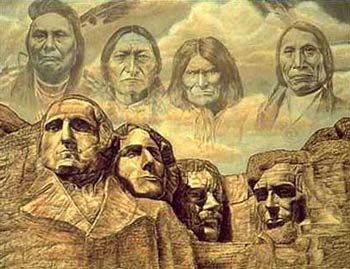One of Life After People's conclusions is that most signs of civilization--our cities, buildings, and roads, not to mention our arts and sciences--will start decaying quickly. In 10,000 years, everything made of concrete, metal, plastic, wood, or paper will have crumbled into bits and pieces--essentially dust.
Ironically, as someone notes, stone monuments and clay tablets are more durable than anything we've created since. Because of this, a few structures--the Hoover Dam, the Great Wall of China, the Egyptian pyramids--will remain intact and identifiable for tens of thousands of years.
But eventually water will burst the dam, vegetation will cover the wall, and sand will bury the pyramids. Someone suggests Mt. Rushmore as possibly the last human artifact, claiming it may be around in a million years when another intelligence species arises.
What about the Indians?
Not that it should've included Indians, but Life Without People is rather Eurocentric. Other than what I've mentioned above and a brief appearance of Angkor Wat, there's no talk of how non-Western civilizations will fare.
What Life Without People doesn't say is that indigenous and non-Western artifacts may outlast their Western counterparts. The places likely to survive the longest intact are geologically stable arid plains: parts of the American West, the Andean altiplano, North Africa, the Middle East, and western Asia. These are all regions where indigenous and other non-Western cultures have flourished.
Maybe Inca and Tiahuanaco (Bolivia) ruins, Southwestern pueblos and petroglyphs, and the Crazy Horse Memorial still will be here when the heads finally fall off Mt. Rushmore. It would be funny if aliens arrived a million years from now and discovered only indigenous remains. Finding no signs of Einstein, Mozart, Shakespeare, Muhammad, Jesus, Caesar, or Aristotle, they might conclude that Indian civilizations were the most advanced on Earth.
Rob's rating for Life After People: 8.5 of 10. Check it out.
For more on the subject, see Native Documentary and News.
Below: As the last trace of Western civilization crumbles into dust, an Indian presence still haunts the land.


No comments:
Post a Comment
Note: Only a member of this blog may post a comment.